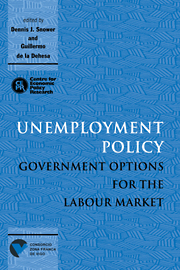Book contents
- Frontmatter
- Contents
- List of figures
- List of tables
- Preface
- Acknowledgements
- List of conference participants
- 1 Introduction
- PART ONE GENERAL POLICY ISSUES
- PART TWO DEMAND MANAGEMENT AND SUPPLY-SIDE POLICY
- 4 The role of demand-management policies in reducing unemployment
- Discussion
- 5 Edmund Phelps' theory of structural slumps and its policy implications
- Discussion
- Discussion
- PART THREE SUBSIDISING EMPLOYMENT AND TRAINING
- PART FOUR LABOUR MARKET REGULATIONS
- PART FIVE POLICY, JOB REALLOCATION AND THE UNEMPLOYMENT–PRODUCTIVITY RELATION
- PART SIX COMPARING UNEMPLOYMENT POLICIES
- Index
Discussion
Published online by Cambridge University Press: 07 September 2010
- Frontmatter
- Contents
- List of figures
- List of tables
- Preface
- Acknowledgements
- List of conference participants
- 1 Introduction
- PART ONE GENERAL POLICY ISSUES
- PART TWO DEMAND MANAGEMENT AND SUPPLY-SIDE POLICY
- 4 The role of demand-management policies in reducing unemployment
- Discussion
- 5 Edmund Phelps' theory of structural slumps and its policy implications
- Discussion
- Discussion
- PART THREE SUBSIDISING EMPLOYMENT AND TRAINING
- PART FOUR LABOUR MARKET REGULATIONS
- PART FIVE POLICY, JOB REALLOCATION AND THE UNEMPLOYMENT–PRODUCTIVITY RELATION
- PART SIX COMPARING UNEMPLOYMENT POLICIES
- Index
Summary
Charles Bean has written an interesting and thought-provoking chapter on two topics: the first is whether demand-management policies have a role in stabilising unemployment; and the second is on the potential role of demand-management policies in reducing European unemployment in the remainder of the 1990s.
Is there a role for stabilisation policy?
Bean is sceptical about the ability of policy makers to stabilise unemployment. He argues that while in principle policy makers could stabilise output and unemployment around their equilibrium values, in practice all the familiar obstacles to perfect stabilisation – especially lags and uncertainty about the structure of the economy and the way individuals form expectations – lead them to believe that ‘activist policies to eliminate such cyclical fluctuations [are] hazardous’.
Of course, no one proposes policies that would attempt to eliminate rather than moderate business cycle fluctuations. We need also to recognise that policy makers try to keep both employment and inflation close to their target levels. If one then asks whether policy makers can and should attempt to stabilise the business cycle, the answer is ‘yes’.
That is what central banks try to do, often quite successfully. No central bank should be inactive in the face of a major disturbance; indeed, it is even difficult to know how to define ‘inactivity’. Even if fine-tuning is out, coarse-tuning is not. In fact, Bean discusses such activity policies in Section 2 of the chapter.
- Type
- Chapter
- Information
- Unemployment PolicyGovernment Options for the Labour Market, pp. 111 - 115Publisher: Cambridge University PressPrint publication year: 1997



